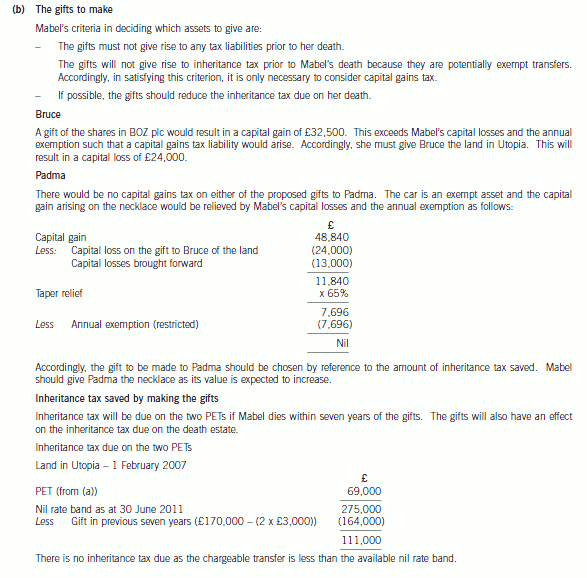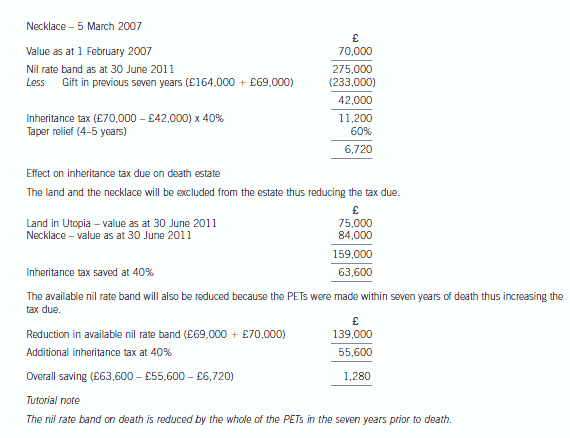解答:特许公认会计师考试可以退考吗?
发布时间:2020-05-09
很多小伙伴在报名考试之后,最后因为一些原因不能参加考试了,那么ACCA考试可以退考吗,大家一定有这样的疑问,今天51题库考试学习网就来告诉大家是否可以退考。
很多特许公认会计师(ACCA)考生由于报名时比较冲动,一下子报名了很多门考试,临到考试的时候,才发现根本来不及复习。也有一些ACCA考生在ACCA考试周的时候和一些其他的事情碰到了一起,不能够按时参加考试,这种情况应该怎么办呢?ACCA考试可以退考吗?
ACCA目前是支持退考的,ACCA退考流程:在正常报考日期截止日前,学员都可以进入myACCA的账户里去修改考试信息,包括退考、更改考场、更改考试科目以及增加报考科目等。
然后,之前缴纳的考试费,acca退考后,会返回到你的ACCA账户里,可以用来缴年费和下次考试。
温馨提示:这些acca退考后的费用不能返回到你的银行卡,只能留在ACCA账户中用来支付考试、年费等费用。
即使退考成功了,学员必须按考试大纲设置的先后次序报考,即知识课程,技能课程,核心课程和选修课程。
在一个课程阶段中可以选择任意顺序报考。但ACCA建议在一个课程中也按照顺序报考。
除免试和已通过的课程外,每次或者每个考试期最多报考4门。
核心课程的3个科目无须同时报考
基础阶段的知识课程考试时间为两小时,基础阶段的技能课程考试时间已经更改为3个小时,及格成绩仍旧为50分(百分制),每科成绩合格后予以保留。
ACCA考试的年限也有所更改:F阶段目前是没有时间限制,P阶段从通过第一科开始有7年的时限,请各位考试注意这个时间变化了,并不是以前的10年年限了。
请大家仔细阅读51题库考试学习网分享的内容,看完之后你肯定知道ACCA考试退考流程了,51题库考试学习网提醒大家,不到万不得已不要退考,尽力去参加考试就算不通过,也是熟悉考试的方式,多熟悉考试肯定是有好处的。
下面小编为大家准备了 ACCA考试 的相关考题,供大家学习参考。
(b) Provide an example that illustrates a structured application of the terms contained in the above statement in
respect of a profit-seeking organisation OR a not-for-profit organisation of your own choice. (6 marks)
(b) An illustration of the features detailed above, framed in the context of a University as an organisation in the not-for-profit sector
might be as follows:
The Overall objective might well be stated in the mission statement of a University. An example of such a mission statement
might be as follows:
‘To provide a quality educational environment in a range of undergraduate and post-graduate disciplines and a quality
educational focus for students and the business community.’
More specifically, objectives may be seen as the achievement of ‘value for money’ thereby ensuring effectiveness in areas such
as:
– The provision of high added value to students;
– The establishment of a reputation for recognised expertise in specific areas of research work within the wider community;
and
– The provision of a high quality service to industry and commerce.
Strategies may focus on aspects such as:
– The recruitment and retention of high quality academic staff;
– The development of IT equipment and skills within the institution;
– The mentoring of students in order to ensure high added value and low drop-out rates in intermediate years of study;
and
– The close liaison with employers as to qualities in graduate/post-graduate employees that they will value highly.
The determinants used to measure the results of strategies might include:
– Competitiveness – cost per graduate compared to other institutions; growth in student numbers; number of staff holding
a PhD qualification;
– Financial performance – average cost per graduate; income generation from consultancy work;
– Quality – range of awards (percentages of 1st class degrees); employer responses; measures of quality of delivery of
education, advice to students, etc;
– Flexibility – variable entry and exit points to courses; modular structure; the variety of full-time, part-time and distance
learning modes;
– Resource Utilisation – staff:student ratios; quotas met by each course; accommodation filled;
– Innovation – latest IT provision in linking lecture theatres to information databases; increased provision of flexilearning/
mixed mode course provision.
The application of business change techniques might include the following:
BPR with a focus on IT developments, flexible-learning or mixed mode course provision.
JIT with a focus on moves towards student-centred uptake of educational opportunities e.g. via intranet availability of lecture
and tutorial material linked to more flexible access to staff rather than a ‘push’ system of pre-structured times of
lectures/tutorials.
TQM with a focus on moves to improve quality in all aspects of the learning environment including delivery of lectures, access
to staff and pastoral care issues.
ABM with a focus on activities on a per student basis (both planned and actual) with a view to eliminating activities that do
not add value e.g. cost per lecture per student.
(c) Critically discuss the adoption of activity-based management (ABM) in companies such as TOC. (6 marks)
(c) Activity-based management (ABM) is a method of identifying and evaluating activities that a business performs using
activity-based costing to carry out a value chain analysis or a re-engineering initiative to improve strategic and operational
decisions in an organisation. Activity-based costing establishes relationships between overhead costs and activities so that
overhead costs can be more precisely allocated to products, services, or customer segments. Activity-based management
focuses on managing activities to reduce costs and improve customer value.
Kaplan and Cooper (1998) divide ABM into operational ABM and strategic ABM:
Operational ABM is about ‘doing things right’, using ABC information to improve efficiency. Those activities which add value
to the product can be identified and improved. Activities that don’t add value are the ones that need to be reduced to cut costs
without reducing product value.
Strategic ABM is about ‘doing the right things’, using ABC information to decide which products to develop and which
activities to use. This can also be used for customer profitability analysis, identifying which customers are the most profitable
and focusing on them more.
A risk with ABM is that some activities have an implicit value, not necessarily reflected in a financial value added to any
product. For instance a particularly pleasant workplace can help attract and retain the best staff, but may not be identified as
adding value in operational ABM. A customer that represents a loss based on committed activities, but that opens up leads
in a new market, may be identified as a low value customer by a strategic ABM process.
ABM can give middle managers an understanding of costs to other teams to help them make decisions that benefit the whole
organisation, not just their activities’ bottom line.
(b) Mabel has two objectives when making the gifts to Bruce and Padma:
(1) To pay no tax on any gift in her lifetime; and
(2) To reduce the eventual liability to inheritance tax on her death.
Advise Mabel which item to gift to Bruce and to Padma in order to satisfy her objectives. Give reasons for
your advice.
Your advice should include a computation of the inheritance tax saved as a result of the two gifts, on the
assumption that Mabel dies on 30 June 2011. (10 marks)


(b) Provide the directors of Acrux Ltd with a detailed explanation of the maximum rate of tax that will be suffered
on both the distributed and non-distributed profits of the non-UK resident investee companies where:
(1) there is a double tax treaty between the UK and the country in which the individual companies are
resident; and
(2) there is no such double tax treaty.
Note: you are not required to explain the position of the overseas resident branches. (6 marks)
(b) Rate of tax on profits of non-UK resident investee companies
Undistributed profits
The companies will be subject to tax in the countries in which they are resident; this is because of their residency status or
because they have a permanent establishment in that country. Undistributed profits will not be taxed in the UK.
The rate of tax on undistributed profits will therefore be the rate of tax in the country of residency of the respective companies.
Distributed profits with double tax treaty
The dividends received by Acrux Ltd from each of the overseas companies will be grossed up in respect of underlying tax (the
overseas corporation tax paid on the distributed profits) because Acrux Ltd will own at least 10% of the overseas companies.
The gross amount will then be included in Acrux Ltd’s profits chargeable to corporation tax.
The treaty will provide double tax relief in the UK for the overseas tax suffered in respect of each dividend up to a maximum
of the UK tax on the grossed up overseas dividend. As a result of the double tax relief, the overall rate of tax suffered will be
the higher of the UK rate paid by Acrux Ltd and the overseas tax rate borne by the overseas company.
Where the rate of overseas tax in respect of a particular dividend exceeds the rate of corporation tax in the UK, excess foreign
tax will arise. This can be relieved, via onshore pooling, against the UK tax due on those dividends where the rate of tax in
the UK exceeds the rate overseas. This will reduce the overall rate of tax suffered on the total overseas profits of the overseas
companies as a whole.
Distributed profits with no double tax treaty
Where there is no double tax treaty, unilateral double tax relief will be available in the UK. This relief will operate in the same
way as double tax relief under a double tax treaty such that the overall rate of tax on each dividend will be the higher of the
UK rate paid by Acrux Ltd and the overseas rate borne by the overseas company. Relief via onshore pooling will also be
available.
声明:本文内容由互联网用户自发贡献自行上传,本网站不拥有所有权,未作人工编辑处理,也不承担相关法律责任。如果您发现有涉嫌版权的内容,欢迎发送邮件至:contact@51tk.com 进行举报,并提供相关证据,工作人员会在5个工作日内联系你,一经查实,本站将立刻删除涉嫌侵权内容。
- 2020-01-01
- 2020-02-18
- 2019-07-19
- 2020-03-25
- 2020-04-03
- 2020-04-21
- 2020-01-09
- 2019-12-31
- 2020-04-11
- 2021-06-18
- 2019-07-19
- 2020-03-26
- 2019-07-19
- 2020-01-09
- 2020-03-27
- 2020-02-20
- 2020-01-30
- 2019-07-19
- 2020-01-09
- 2020-04-21
- 2020-01-07
- 2020-01-09
- 2020-01-09
- 2020-04-21
- 2020-04-01
- 2020-01-09
- 2020-05-09
- 2020-03-26
- 2020-02-27
- 2020-05-14